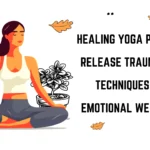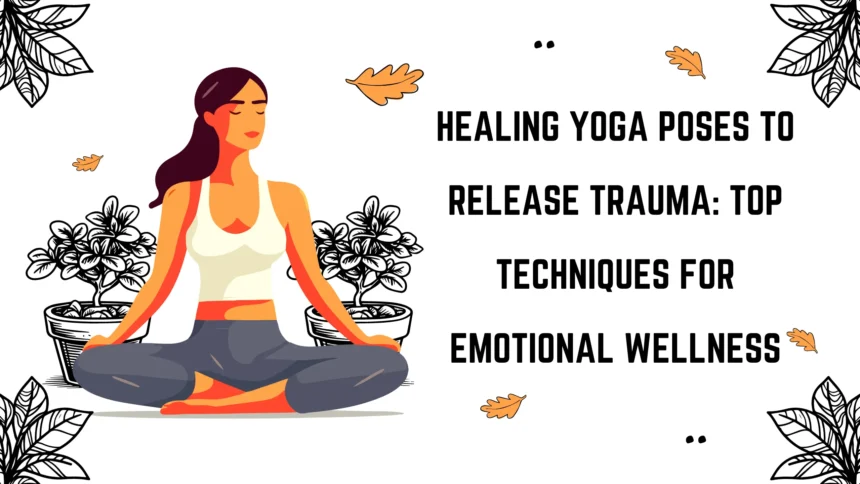Introduction
Trauma can overwhelm us, disconnecting us from ourselves. It creates a significant disturbance in our emotional, mental, and overall well-being. Yoga offers a holistic approach to healing both the mind and body. This guide covers specific yoga poses designed to release emotional stress and foster well-being. By integrating these practices into your daily routine, you’ll begin a journey toward healing and restoring balance in life.
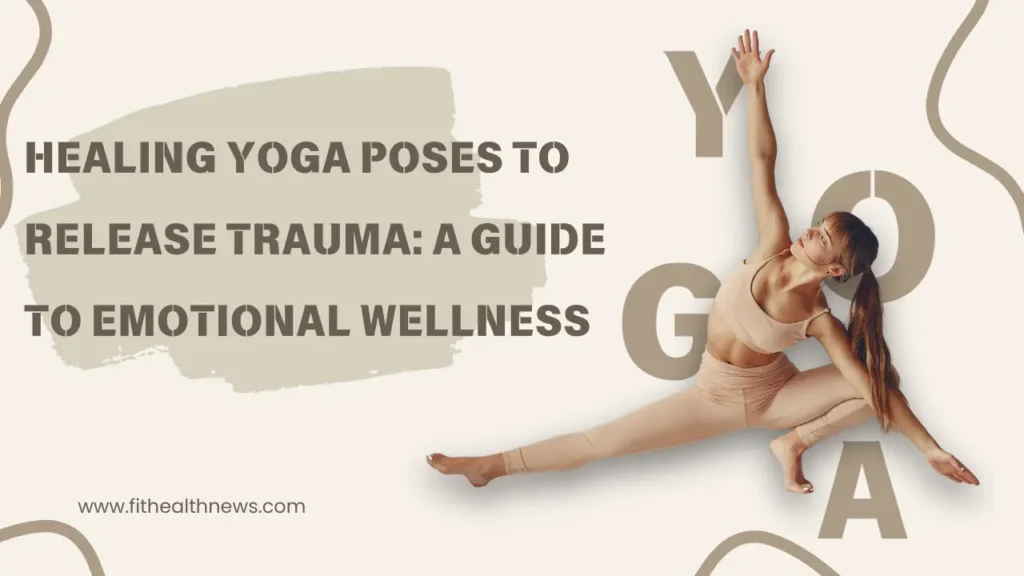
Understanding Trauma and Its Impact
What is Trauma?
Trauma refers to the emotional reaction triggered by distressing or disturbing events. It could stem from past abuse, serious accidents, or deep personal loss. The effects can manifest through emotional, mental, and even physical symptoms, including anxiety, depression, and chronic pain.This revision keeps the core message but avoids overusing the focus keyword, balancing the content for both readability and SEO.
The Physical and Emotional Effects of Trauma
This is what we refer to as trauma, and it has a way of burrowing in the body as chronic tension and pain; or if not physical symptoms might kick about with other guests including but not be limited to: rumination-like persistent stress/emotional distress-so overwhelming your brain doesn’t have access to any creativity or holistic thought. The interaction between the body and mind is what makes trauma complicated. The practice of yoga, which concentrates both on physical and mental health provides an overarching mode of healing.
How Yoga Can Help with Trauma
The Science behind Yoga and Trauma Healing
Through highly controlled breathing and physical movement, yoga helps calm the mind and increase mindfulness. Studies have shown that yoga can down-regulate the nervous system, reducing stress hormones in our bodies helping increase emotional resiliency. Yoga support trauma recovery — all of the above and more make yoga a powerful addition component in healing from traumatic experiences.
Yoga’s Impact on the Nervous System
Injury frequently brings about an uplifted condition of pressure, where the body stays in “survival” mode. Yoga helps shift the body from this state to a more adjusted “rest and review” mode, supporting the mending system.
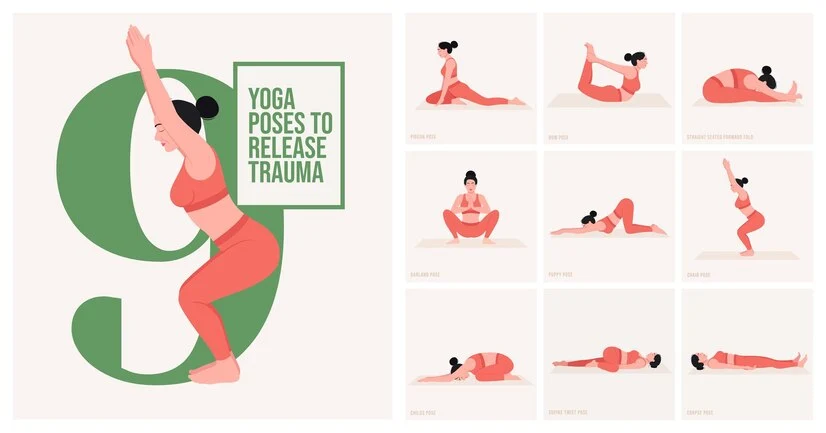
Essential Yoga Poses for Trauma Release
1. Child’s Pose (Balasana)
It is a very relaxing restorative pose and calms the nervous system.
The Best Way to Do It: Sit back on your heels for added effect, like you would kneeling yoga style? Lower your forehead to the mat and allow yourself surrender.
Pro: Child (anukasana) — The child’s pose is great for relaxing the back and shoulders, increasing a sense of safety in our body, relaxation.
2. Downward-Facing Dog (Adho Mukha Svanasana)
Description: This posture extends the whole body and eases pressure.
The most effective method to Make it happen: Begin your hands and knees, lift your hips towards the roof, and fix your legs. Structure a rearranged Angular shape with your body, squeezing through your hands and feet.
Benefits: Descending Confronting Canine assists with establishing your energy, stretch the spine, and lighten pressure and uneasiness.
3. Cobra Pose (Bhujangasana)
Shutter stock Cobra—Opens the chest and frees trapped emotions.
Do It: Lie face down with your hands under your shoulders and squeeze the tops of your feet onto floor.
Benefits: An open-hearted posture helpful for tension release in the chest and shoulders, encouraging emotional availability.
4. Legs-Up-The-Wall Pose (Viparita Karani)
Details: This restful pose eases your body and mind.
Do It: Lie on your back with legs extended up a wall, arms by sides Stay in this position and take long breaths.
Benefits: The job upside down holding shape relaxes the mind and body lessen pressure furnish emotional healing.
5. Seated Forward Bend (Paschimottanasana)
Description: This pose stretches the spine and hamstrings, calming the mind.
How to Do It: Sit with your legs extended in front of you, reach for your feet, and gently bend forward while keeping your spine long.
Benefits: This forward bend helps release tension in the spine, soothes the nervous system, and enhances mental clarity.
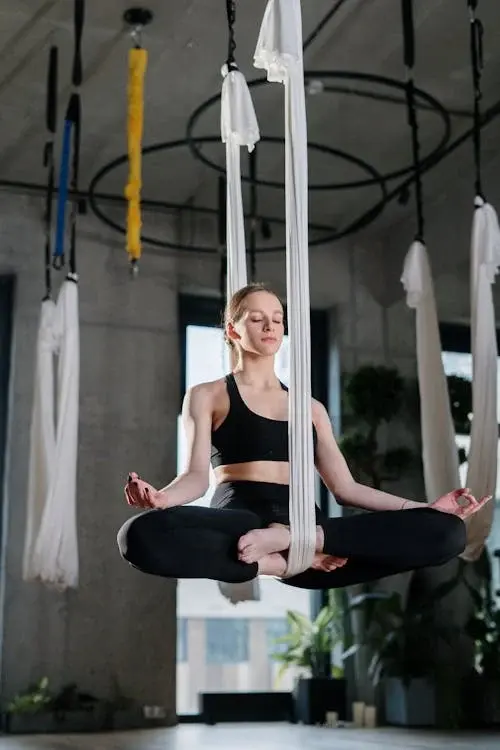
Tips for Incorporating Yoga into Your Routine
Create a Consistent Practice
To encounter the advantages of yoga, integrate these stances into your everyday daily schedule. Indeed, even short meetings can be viable whenever rehearsed reliably.
Combine Yoga with Mindfulness
Integrate mindfulness strategies to elevate your yoga practice Breathe and feel of your body in each pose to relax even further.
Seek Professional Guidance
A personalized practice is Read full article → Personalized practices work best with the guidance of yoga therapy, or even a counselor who specializes in trauma-informed practices. These people can offer guidance and help that is customised to your specific needs as you navigate school life with anxiety.
Additional Resources for Trauma Healing
Books and Online Resources
Explore books and online courses that delve deeper into trauma-informed yoga and emotional wellness. Some recommended reads include:
- The Body Keeps the Score by Bessel van der Kolk
- Yoga for Trauma Recovery by Julie Roberts
Professional Support
Consider contacting advisors or yoga educators who spend significant time in injury recuperation. Their skill can assist with directing you through a more viable mending process.
Conclusion
Healing from trauma takes time, and a multi-pronged approach. Yoga is a powerful way to get rid of the emotions we have been keeping all over and puts our body into balance. It can help to heal from the inside if you include all these poses in your daily practice and practice mindfulness. Just keep reminding yourself that some small steps are great for going toward emotional wellness. Relish in the experience with love and commitment.
FAQs
1. How often should I practice yoga for trauma release?
Aim to practice daily or several times a week. Consistency is key to experiencing lasting benefits.
2. Can yoga completely heal trauma?
Yoga can significantly aid in trauma recovery but is often most effective when combined with other therapeutic approaches. Consult with professionals for a comprehensive healing plan.
3. Are these yoga poses suitable for beginners?
Yes, beginners can practice these poses. Start slowly, listen to your body, and make modifications as needed.
4. What if I feel emotional during my yoga practice?
Feeling emotions during yoga is a normal part of the healing process. Allow yourself to experience and process these emotions as they arise.
5. How long will it take to see results from yoga?
Results vary from person to person. Some may notice improvements within a few weeks, while others may take longer. Be patient and consistent with your practice.






